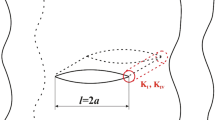Abstract
In this paper, the effect of electric boundary conditions on Mode I crack propagation in ferroelectric ceramics is studied by using both linear and nonlinear piezoelectric fracture mechanics. In linear analysis, impermeable cracks under open circuit and short circuit are analyzed using the Stroh formalism and a rescaling method. It is shown that the energy release rate in short circuit is larger than that in open circuit. In nonlinear analysis, permeable crack conditions are used and the nonlinear effect of domain switching near a crack tip is considered using an energy-based switching criterion proposed by Hwang et al. (Acta Metal. Mater., 1995). In open circuit, a large depolarization field induced by domain switching makes switching much more difficult than that in short circuit. Analysis shows that the energy release rate in short circuit is still larger than that in open circuit, and is also larger than the linear result. Consequently, whether using linear or nonlinear fracture analysis, a crack is found easier to propagate in short circuit than in open circuit, which is consistent with the experimental observations of Kounga Njiwa et al. (Eng. Fract. Mech., 2006).

Similar content being viewed by others
References
Parton, V.Z.: Fracture mechanics of piezoelectric materials. Acta Astronaut. 3, 671–683 (1976)
Suo, Z., Kuo, C.M., Barnett, D.M., et al: Fracture mechanics for piezoelectric ceramics. J. Mech. Phys. Solids 40, 739–765 (1992)
Gao, H., Barnett, D.M.: An invariance property of local energy release rate in a strip saturation model of piezoelectric fracture. Int. J. Fract. 79, R25–R29 (1996)
Zhu, T., Yang, W.: Toughness variation of ferroelectrics by polarization switch under non-uniform electric field. Acta Mater. 45, 4695–4702 (1997)
Xu, X.L., Rajapakse, R.K.N.D.: On a plane crack in piezoelectric solids. Int J Solids Struct 38, 7643–7658 (2001)
Zhang, T.Y., Zhao, M.H., Tong, P.: Fracture of piezoelectric ceramics. Adv. Appl. Mech. 38, 147–289 (2001)
Park, Y.E., Tobin, A.: On electric field effects in fracture of piezoelectric materials. In: Lee, J.S., Maugin, G.A., Shindo, Y. eds. ASME Mechanics of Electromagnetic Materials and Structures AMD-161, MD-42, 51–62 (1993)
Park, S.B., Sun, C.T.: Effect of electric field on fracture of piezoelectric ceramics. Int. J. Fract. 70, 203–216 (1995a)
Park, S.B., Sun, C.T.: Fracture criteria for piezoelectric ceramics. J. Am. Ceram. Soc. 78, 1475–1480 (1995b)
Wang, H., Singh, R.N.: Crack propagation in piezoelectric ceramics: Effect of applied electric field. J. Appl. Phys. 81, 7471–7479 (1997)
Fu, R., Zhang, T.Y.: Effects of an electric field on the fracture toughness of poled lead zirconate titanate ceramics. J. Am. Ceram. Soc. 83, 1215–1218 (2000)
Yan, D.J., Huang, H.Y., Cheung, C.W., et al.: Fracture criterion for conductive cracks in soda-lime glass under combined mechanical and electric loading. Int. J. Fract. 164, 185–199 (2010)
Li, Y.W., Li, F.X.: Two-dimensional domain switching induced tensile fracture in a crack-free PZT ceramics under orthogonal electromechanical loading. Appl. Phys. Lett. 97, 102903 (2010)
Li, Y.W., Li, F.X.: In situ observation of electric field induced crack propagation in BaTiO3 crystals along the field direction. Scripta Materialia 67, 601–604 (2012)
Jaffe, B., Cook, W.R., Jaffe, H.: Piezoelectric Ceramics. Academic Press, London and New York (1971)
Berlincourt, D., Krueger, H.H.A.: Domain processes in lead titanate zirconate and barium titanate ceramics. J. Appl. Phys. 30, 1804–1810 (1959)
Li, F.X., Fang, D.N.: Effects of electrical boundary conditions and poling approaches on the mechanical depolarization behavior of PZT ceramics. Acta Mater. 53, 2665–2673 (2005)
Kounga Njiwa, A.B., Fett, T., Lupascu, D.C., et al.: Effect of geometry and electrical boundary conditions on R-curve for lead zirconate titanate ceramics. Eng. Fract. Mech. 73, 309–317 (2006)
Stroh, A.N.: Dislocations and cracks in anisotropic elasticity. Phil. Mag. 3, 625–646 (1958)
Ting, T.C.T.: Anisotropic Elasticity: Theory and Applications. Oxford University Press, New York/Oxford, 134–163 (1996)
Kumar, S., Singh, R. N.: Comment on “Fracture criterion for piezoelectric ceramics”. J. Am. Ceram. Soc. 79, 1133–1135 (1996)
Sun, C.T., Park, S.B.: Reply to “Comment on ‘Fracture criterion for piezoelectric ceramics’”. J. Am. Ceram. Soc. 79, 1136 (1996)
Tiersten, H.F.: Linear Piezoelectric Plate Vibrations. Plenum Press, New York (1969)
Qi, H., Fang, D.N., Yao, Z.H.: FEM analysis of electromechanical coupling effect of piezoelectric materials. Comp. Mater. Sci. 8, 283–290 (1997)
Park, Y.E.: Crack extension force in a piezoelectric materials. J Appl Mech-T ASME 57, 647–653 (1990)
Sosa, H.: Plane problems in piezoelectric media with defects. Int. J. Solid Struct. 28, 491–505 (1991)
Chen, Y.H., Lu, T.J.: Cracks and fracture in piezoelectrics. Adv. Appl. Mech. 39, 121–215 (2002)
Balke, H., Drescher, J., Kommer, G.: Investigation of mechanical strain energy release rate with respect to fracture criterion for piezoelectric ceramics. Int. J. Fract. 89, L59–L64 (1998)
Hwang, S.C., Lynch, C.S., McMeeking, R.M.: Ferroelectric/ferroelastic interactions and a polarization switching model. Acta Metall. Mater. 43, 2073–2084 (1995)
Huber, J.E., Fleck, N.A., Landis, C.M., et al.: A constitutive model for ferroelectric polycrystals. J. Mech. Phys. Solids 47, 1663–1697 (1999)
Li, F.X., Rajapakse, R.K.N.D.: A constrained domain switching model for polycrystalline ferroelectric ceramics. Part I: Model formulation and applications to tetragonal materials. Acta Mater. 55, 6472–6480 (2007)
Author information
Authors and Affiliations
Corresponding authors
Additional information
The project was supported by the National Natural Science Foundation of China (11002002 and 11090331).
Rights and permissions
About this article
Cite this article
Li, F.X., Sun, Y. & Rajapakse, R.K.N.D. Effect of electric boundary conditions on crack propagation in ferroelectric ceramics. Acta Mech Sin 30, 153–160 (2014). https://doi.org/10.1007/s10409-014-0030-0
Received:
Revised:
Accepted:
Published:
Issue Date:
DOI: https://doi.org/10.1007/s10409-014-0030-0




